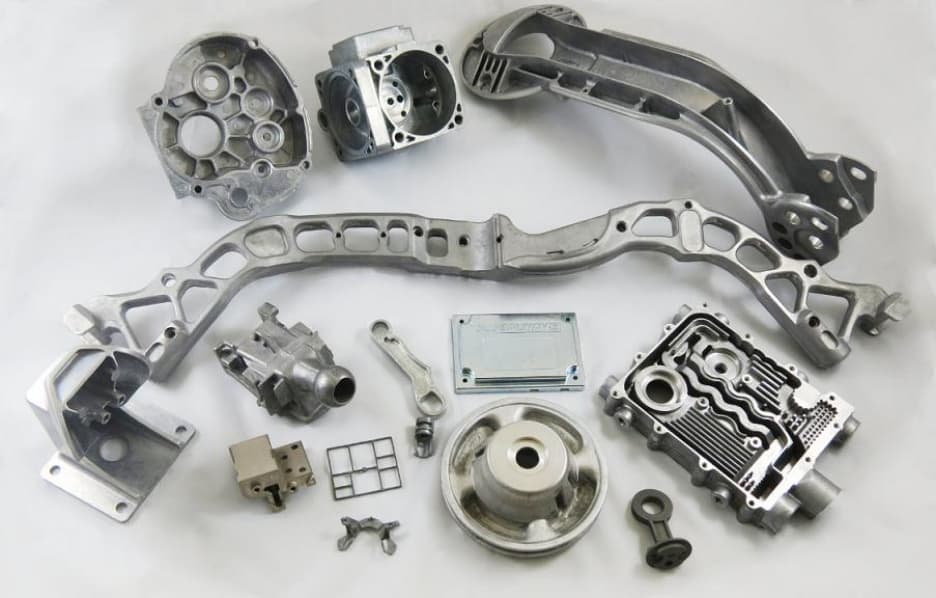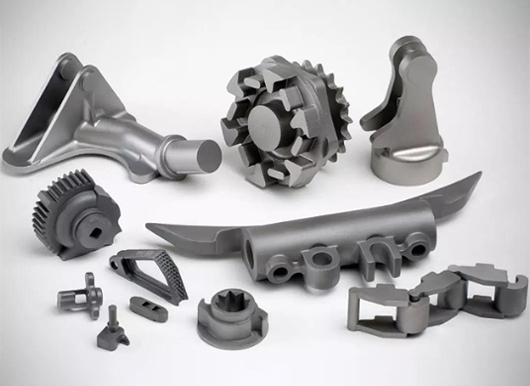How Wisconsin Aluminum Foundry delivers precision and reliability
Discovering the Conveniences and Practical Use Aluminum Castings in Today's Market
Light weight aluminum castings have actually ended up being increasingly pertinent in different industries because of their unique qualities. Their light-weight nature and resistance to deterioration make them suitable for demanding applications. Furthermore, the superior strength-to-weight ratio supplies significant benefits in layout and manufacturing. As sectors remain to discover their capacity, the full scope of aluminum spreadings' applications and benefits stays to be fully discovered. What exists in advance for this versatile product?
The Lightweight Benefit of Light Weight Aluminum Castings
Although numerous products are used in manufacturing, light weight aluminum castings stand apart largely due to their lightweight residential properties. This particular makes light weight aluminum spreadings an appealing selection for numerous industries, particularly in aerospace and automotive applications, where weight reduction is necessary for boosting gas performance and efficiency. The light-weight nature of aluminum permits producers to develop parts that are less complicated to install and handle, inevitably lowering labor costs.
The capacity to generate intricate forms without considerable weight fines makes it possible for designers to innovate while keeping architectural integrity. Light weight aluminum castings can efficiently replace heavier products, bring about substantial cost savings in shipping and operational costs. Their light-weight benefit also adds to boosted item durability, as lighter components frequently lead to lowered wear and tear on equipment. In general, the lightweight properties of light weight aluminum castings give makers with an one-upmanship, promoting advancements in item style and performance throughout various fields.

Extraordinary Deterioration Resistance
Light weight aluminum castings possess an all-natural resistance to oxidation, which substantially enhances their longevity in numerous atmospheres. This fundamental home not only adds to their toughness however also lines up with the light-weight benefit that aluminum uses. Because of this, aluminum spreadings are increasingly recognized for their phenomenal rust resistance in various applications.

Naturally Resistant to Oxidation
One of the standout characteristics of light weight aluminum spreadings is their outstanding deterioration resistance, which stems from a natural oxidation procedure. When subjected to air, aluminum responds to create a slim, protective layer of aluminum oxide. This layer works as an obstacle versus additional oxidation and safeguards the underlying steel from destructive elements such as dampness and salts. Unlike other steels, this oxide layer is self-repairing; if harmed, it quickly reforms when revealed to air. This special home boosts the durability of aluminum spreadings in various settings, making them suitable for applications in industries such as aerospace, auto, and marine. Subsequently, the natural resistance to oxidation substantially minimizes upkeep expenses and increases the dependability of aluminum castings popular conditions.
Light-weight Resilience Benefit
The lightweight nature of light weight aluminum spreadings contributes considerably to their toughness, making them an advantageous choice in different sectors. This outstanding durability is greatly associated to light weight aluminum's natural resistance to corrosion, which is improved better with anodizing and various other surface area therapies. Unlike numerous metals, light weight aluminum does not corrosion; instead, it forms a protective oxide layer that shields it from ecological damages. This property is particularly helpful in sectors such as auto and aerospace, where weight reduction is important without endangering strength. Additionally, the longevity of aluminum spreadings reduces maintenance costs and replacements, offering economic advantages with time. Their light-weight longevity and deterioration resistance placement light weight aluminum castings as a remarkable product for modern-day production applications.

Superior Strength-to-Weight Proportion
An impressive characteristic of aluminum castings is their superior strength-to-weight proportion, which makes them highly desirable in various applications. This intrinsic home permits aluminum castings to endure considerable anxiety while remaining light-weight, a vital consider markets such as aerospace, automotive, and production. Designers often prefer light weight aluminum castings for components that require both resilience and decreased weight, enhancing gas performance and efficiency.
The high strength-to-weight ratio also facilitates the design of detailed shapes and structures, making light weight aluminum spreadings versatile for complex applications. The capacity to preserve structural honesty under difficult problems assurances longevity and integrity in products, from airplane frameworks to automotive parts. This benefit adds to the growing fad of using light weight aluminum castings in innovative layouts, eventually leading to enhanced functionality and effectiveness throughout varied sectors. Subsequently, the exceptional strength-to-weight proportion of aluminum castings places them as a critical product in modern design and production.
Cost-Effectiveness in Manufacturing
Cost-effectiveness in aluminum casting manufacturing is primarily attained with minimized material waste and effective production processes. By maximizing designs and using advanced techniques, manufacturers can minimize excess material use while preserving quality standards. This technique not just decreases production expenses yet also adds to a lot more lasting techniques within the industry.
Minimized Product Waste
Lowering product waste in aluminum casting processes significantly boosts manufacturing performance. By maximizing the design and production strategies, this link companies can minimize excess scrap and boost source application. This reduction in waste not only reduces material costs but also contributes to a more sustainable production version. The capacity to reuse weblink aluminum additional supports cost-effectiveness, allowing producers to reclaim and reuse products without jeopardizing high quality. As the industry increasingly focuses on sustainability, reduced product waste aligns with environmental objectives while all at once improving earnings. Eventually, reliable use raw products enhances the competitive placement of services in the marketplace, making aluminum spreadings a desirable choice in various applications. The strategic strategy to reducing waste reflects a dedication to both financial and ecological obligation.
Efficient Production Processes
While traditional manufacturing processes can sustain considerable costs, light weight aluminum casting offers an extra efficient choice that improves total manufacturing success. This approach lessens material waste and permits precise control over the manufacturing procedure, leading to reduced labor and functional costs. The capability to generate complicated forms with fewer actions further enhances manufacturing, adding to shorter preparations. In addition, aluminum's lightweight nature and superb thermal conductivity allow for energy cost savings throughout manufacturing and in the last application. By making use of contemporary spreading technologies, makers can attain higher throughput without compromising quality. Aluminum casting stands out as an economical remedy, making it an attractive option for companies intending to maximize their manufacturing procedures in today's affordable market.
Versatility Across Industries
Aluminum castings demonstrate amazing adaptability throughout different sectors, as they can be tailored to fulfill details needs and applications. In the auto sector, light weight aluminum spreadings are utilized in engine blocks, transmission real estates, and wheels, providing light-weight yet sturdy options that boost fuel efficiency. The aerospace industry additionally gains from light weight aluminum castings, utilizing them in architectural parts and engine parts because of their strength-to-weight ratio.
In the consumer goods field, suppliers utilize light weight aluminum castings for items varying from kitchenware to furnishings, supplying both visual charm and functionality. The electronic devices sector uses aluminum spreadings for real estates and warm sinks, guaranteeing effective thermal monitoring. Furthermore, the building and construction sector leverages aluminum castings for building elements and architectural parts, boosting longevity and design adaptability. This wide applicability highlights aluminum spreadings as a vital resource, fulfilling the varied needs of numerous markets while maintaining high efficiency and reliability.
Sustainability and Ecological Effect
As industries significantly prioritize lasting practices, aluminum spreadings emerge as an environmentally friendly selection because of their recyclability and reduced environmental impact. Aluminum is just one of the most recycled materials around the world, with the capability to be repurposed numerous times without degradation of high quality. This characteristic considerably reduces the demand for basic materials and energy consumption related to main light weight aluminum manufacturing, which is energy-intensive.
Additionally, light weight aluminum spreadings add to lightweight layouts, leading to fuel performance in transport applications such as aerospace and auto sectors. Their toughness and resistance to rust prolong item life expectancies, additionally minimizing waste and resource use gradually. Lots of suppliers are taking on liable sourcing and environmentally friendly manufacturing approaches, boosting the sustainability of aluminum spreading processes. In general, aluminum castings represent a useful service for companies aiming to decrease their environmental influence while accomplishing performance and effectiveness.
Advancements in Aluminum Spreading Technologies
Current developments in aluminum spreading technologies have actually substantially improved the efficiency and top quality of production processes. Advancements such as 3D printing and advanced mold-making techniques have actually allowed manufacturers to produce elaborate designs with decreased product waste. This shift not just enhances the precision of actors components yet also reduces lead times, enabling fast prototyping and faster market access.
The incorporation of advanced computer system simulations help in anticipating potential issues during casting, leading to higher-quality results. Making use of light-weight alloys has additionally added to the advancement of stronger, extra sturdy products, accommodating markets varying from automobile to aerospace
Furthermore, automated spreading processes have emerged, minimizing human mistake and increasing production rate. Jointly, these innovations are changing the aluminum casting landscape, driving higher competition and sustainability in production. As industries continue to progress, these modern technologies will play an important role in meeting future demands for effectiveness and high quality.
Often Asked Questions
Exactly How Do Aluminum Castings Compare to Other Steels in Terms of Thermal Conductivity?
Light weight aluminum castings exhibit exceptional thermal conductivity compared to many metals, such as steel and iron - Aluminum Foundry. Their light-weight nature and effective warm circulation make them suitable for applications calling for effective thermal management in various industries
What Are the Usual Issues Located in Light Weight Aluminum Castings?
Usual flaws in light weight aluminum spreadings include porosity, shrinking, inclusions, and surface irregularities. These issues frequently emerge from improper air conditioning prices, insufficient mold design, or contaminations, influencing the general high quality and read here performance of the final item.
Can Aluminum Castings Be Recycled, and How?
Light weight aluminum spreadings can be recycled effectively. The process involves collecting, melting, and reforming the light weight aluminum, which reduces waste and preserves sources. This recycling adds to sustainability while keeping the product's properties for future usage.
What Are the Common Lead Times for Aluminum Spreading Production?
Generally, preparations for aluminum spreading production range from 2 to six weeks, depending on aspects such as complexity, tooling needs, and production quantity. Effectiveness can improve with well-known vendor relationships and enhanced manufacturing processes.
How Does the Surface Area Finish Affect Light Weight Aluminum Casting Efficiency?
The surface area finish substantially affects light weight aluminum spreading efficiency by influencing deterioration resistance, aesthetic high quality, and friction attributes. A smoother finish improves durability and performance, while a rougher texture can enhance adhesion for subsequent layers or treatments.
Lots of products are used in manufacturing, aluminum castings stand out mostly due to their light-weight residential properties. When exposed to air, aluminum responds to create a thin, protective layer of aluminum oxide. Cost-effectiveness in light weight aluminum spreading production is largely accomplished with lowered product waste and efficient manufacturing processes. Reducing material waste in aluminum casting procedures greatly enhances production effectiveness. Eventually, reliable usage of raw products strengthens the competitive position of companies in the market, making aluminum castings a positive choice in numerous applications.